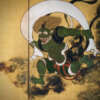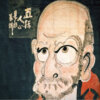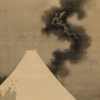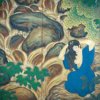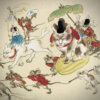Yamaguchi Hachikushi: ‘Screens of Red and White Peonies,’ Exhibited at the Fourth Teiten Exhibition

Yamaguchi Hachikushi was born in Kyoto in 1890. He liked to paint from a young age and was fond of haiku. After attending Kyoto City School of Arts and Crafts, he entered its technical painting school and also devoted himself to haiku under the influence of the school’s teacher, Nakagawa Shimei. He graduated the technical painting school in 1912, and his approach gravitated towards nanga-like expressions as he could not adapt to the realistic style of the Maruyama and Shijō school, which was the basis of the technical school’s education. However, Hachikushi’s nanga-like style is unrelated to the typical traits of nanga, as his works are direct expressions of the inspirations he derived from nature. His approach was to face nature purely through his eyes and to freely express his impressions concisely. Reflective of his own character, his works have a humble, yet cheerful and bright style. Although he spent his life battling tuberculosis from the end of the Taishō period, his painting style remained the same.
Along with being selected for the Teiten exhibition for the first time in 1921, he exhibited his work at the first Nihon Nanga Inten in the same year and became its member in 1923. Without being discouraged by his illness, he exhibited his works at Teiten and Nihon Nanga Inten exhibitions and went on to opening solo exhibitions in Tokyo and Osaka. Although he gained a small crowd of passionate enthusiasts, he passed away in 1933, at the age of 43.
The work above, titled ‘Peonies,’ was submitted to the fourth Teiten exhibition, although only the screen of red peonies on the left was selected. Contrary to the red peonies that have many flowers and stretch their twigs to the entire screen, the white peonies have their flowers modestly bloomed at the center of the screen, and look somewhat lonely. Yet, with a closer look, it can be observed that the red peonies do not necessarily look gloomy, but have a lonely feel. Mainly utilizing Chinese ink, the flowers are depicted in a nanga-like approach, but it is carried out with freedom and is reminiscent of the artist’s kind heart. Perhaps the kindness that the work embodied did not suit the modern art scene.

